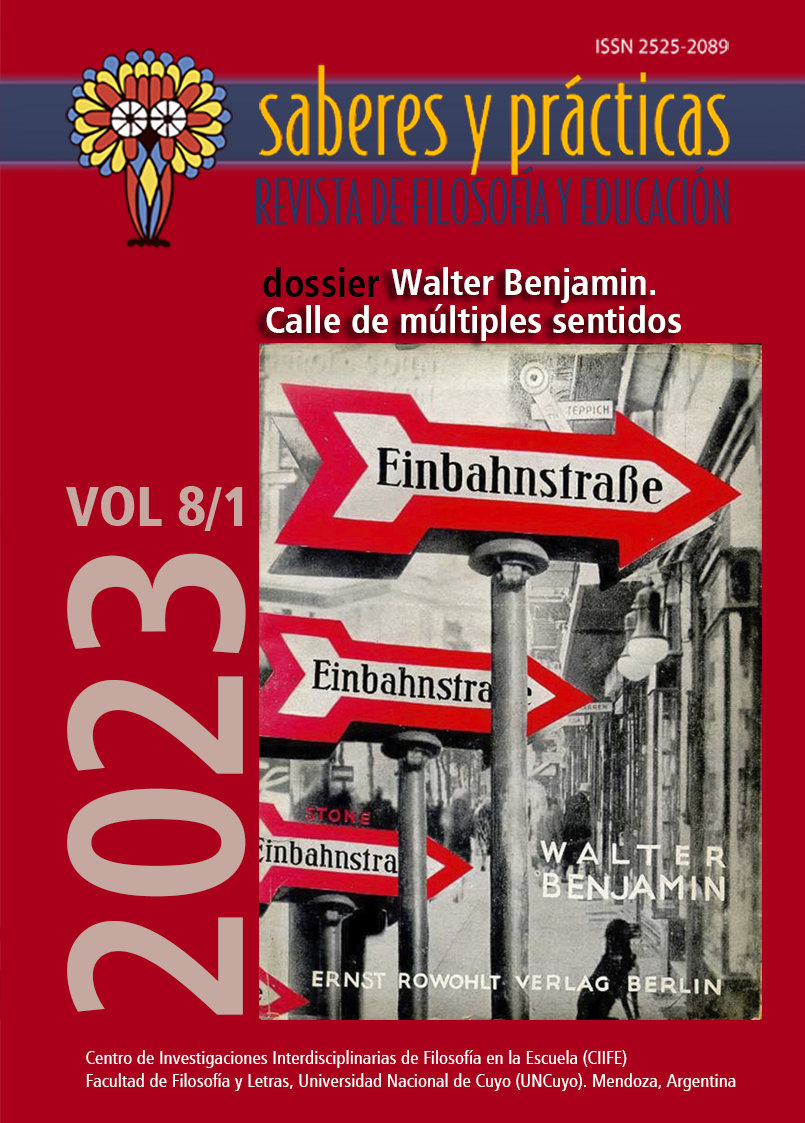Walter Benjamin and Aby Warburg: from the dialectical image to the spectral image
Looking at history as a physicist to capture the survival [Nachleben] and the energetic life [Lebensenergie] of the past.
DOI:
https://doi.org/10.48162/rev.36.100Keywords:
Walter Benjamin, Aby Warburg, Natural History, temporality, legibility of the pastAbstract
In the preparatory notes to the theses On the Concept of History [1940] (2009), Walter Benjamin points out that the historical materialist must, in traversing the "structure of history", carry out a "spectral analysis" [Spektralanalyse]. Whatever familiarity Benjamin may have had with the physical method of spectral analysis, we start from here to derive a central theme, which is that of the epistemology of the image for a model of history already dialectised with nature, in this case, that of Walter Benjamin and Aby Warburg. It is not only the notion of image and dialectical image present in the authors that is important, but also that which is contained and transmitted in the image, which comes from past temporalities. This is why we address the idea of survival [Nachleben] in both authors, and how this is encoded, in Waburg's thought, in the idea of an energetic life and in the notions of dynamogram, engram and memory. What interests us in enabling a broader view of history is to show that the dichotomous separation between history and nature - criticised by both Warburg and Benjamin - disables the possibility of capturing a realm of the objectual that is independent of man, that is, the energy or force that is contained in the heart of an image, hence the interest of taking the physicist's view of history.
Downloads
References
Agamben, G. (2018). “Aby Warbug y la ciencia sin nombre”. En La potencia del pensamiento, pp.157-188. Adriana Hidalgo.
Agamben, G. (2010). Signatura Rerum. Sobre el método. Anagrama.
Benjamin, W. (2008). El narrador. (Oyarzún, P. trad.). Metales pesados.
Benjamin, W. (2009). La dialéctica en suspenso. Fragmentos sobre la historia. (Oyarzún, P. trad.). LOM.
Benjamin, W. (2016). Libro de los Pasajes. Akal.
Buck-Morss, S. (2001). Dialéctica de la mirada. Walter Benjamin y el proyecto de los pasajes. La Balsa de la Medusa.
Didi-Huberman, G. (2009). La imagen superviviente. Historia del arte y tiempo de los fantasmas según Aby Warburg. Abada Editores.
Didi-Huberman, G. (2011). Ante el tiempo. Historia del arte y anacronismo de las imágenes. Adriana Hidalgo Editora.
Didi-Huberman, G. (2011b). Lo que vemos, lo que nos mira. Manantial
Donadi F., Iglesias A. L., López N. (2022). Imágenes, textos y supervivencias: estudios warburguianos en expansión. Introducción. Estudios de Teoría Literaria. Revista digital: artes, letras y humanidades 11(25), pp.6-12.
Fleckner, U. (2020). Aby Warburg y el poder de las imágenes. En lucha por el espacio de pensamiento. Buenos Aires: Ubu Ediciones.
García, L. I. (2015). Una política de las imágenes: Walter Benjamin, organizador del pesimismo. Escritura e imagen 11, 111-1333. http://dx.doi.org/10.5209/rev_ESIM.2015.v11.50968
Gombrich E. H. (1970). Aby Warburg. An Intellectual Biography. London: The Warburg Institute. University of London.
Grüner, E. (2017). Iconografías malditas, imágenes desencantadas. Hacia una política “warbugiana” en la antropología del arte. EUFyL.
Ginzburg, C. (2008). De A. Warburg a E.H. Gombrich. Notas sobre un problema de método. En Mitos, emblemas, indicios. Morfología e historia. Gedisa.
Hillach, A. (2014). Imagen dialéctica. En Conceptos de Walter Benjamin. Opitz y Wizisla, E. (eds). Las Cuarenta.
Jevtic, I. (2008). Between Word and Image: Walter Benjamin’s Images as a Species of Space. Visual literacies 9.
Kemp, W. (1975). Walter Benjamin und die Kunstwissenschaft II: Walter Benjamin und Aby Warburg. Kritische Berichte des Ulmer Vereins für Kunstwissenschaft, 3, pp. 5-25.
Klee, P. (s/f). Paul Klee: fragmentos de mundo. (Acosta, M. R. y Quintana, L. trad.) Universidad de los Andes
Lindig, E. (2015). Imagen dialéctica e índice histórico. En Naishtat, F., G. Gallegos, E., Yébenes Escardó, Z. (comp.). Ráfagas de dirección múltiple. Abordajes de Walter Benjamin, 213-231. UAM.
Ludueña Romandini, F. (2017). La imagen transtemporal. La “ciencia sin nombre” de Aby Warburg. Instantes y Azares. Escrituras nietzscheanas, 19-20, pp. 31-46.
Nancy, J.L. (2006). La imagen: Mímesis y Méthexis. Escritura e imagen, 2, 7-22.
Taccetta, N. (2012). Supervivencia e imagen: Agamben-Warbug-Benjamin y la historia. Revista Lindes. Estudios sociales del arte y la cultura (5).
Losiggio, D. (2020). Aby Warbug y el pathos superviviente. De la psicología a la memoria social. AISTHESIS, 67, pp. 103-121.
Santos, F. (2014). Prologo. En Warburg, A. La pervivencia de las imágenes. Miluno.
Simon, G. (2014). EIDÔLON [εἴδωλον] / EIKÔN [εἰϰών] /PHANTASMA [φάντασμα] / EMPHASIS [ἔμφασις] /TUPOS [τύπος] (GREEK). En Cassin, B. (ed.). Dictionary of Untranslatables. A Philosophical Lexicon, pp.245-249. Princeton University.
Vargas, S. M. (2014). La vida después de la vida. El concepto de “Nachleben” en Benjamin y Warbug. Thémata Revista de Filosofía, 49, pp. 317-331. doi: 10.12795/themata.2014.i49.17
Vieria Neto, S. A. (2022). The style of the fragments: form and theoretical construction in Aby Warburg’s Grundlegende Bruchstücke. Estudios de Teoría Literaria. Revista digital: artes, letras y humanidades 11(25), pp. 24-35.
Warbug, A. (2005). Profecía pagana en palabras e imágenes en la época de Lutero. En Renacimiento del paganismo. Aportaciones a la historia cultural del Renacimiento europeo, 445-512. Alianza Forma.
Warburg, A. (2010). Atlas Mnemosyne. Akal.
Warburg, A. (2014). La pervivencia de las imágenes. Miluno.
Weber, S. (2008). Benjamin’s Abilities. Harvard University Press.
Weidner, D. (2011). Fort-, Über-, Nachleben. Zu einer Denkfigur bei Benjamin. En Benjamin-Studien 2, 159-178. https://doi.org/10.30965/9783846750711_010
Weigel, S. (2013). Epistemology of Wandering, Tree and Taxonomy. The system figure in Warburg’s Mnemosyne project within the history of cartographic and encyclopaedic knowledge. Images Re-vues 4 (15), p. 1-22.
Published
How to Cite
Issue
Section
License
Copyright (c) 2023 Ludmila Fuks
This work is licensed under a Creative Commons Attribution-NonCommercial-ShareAlike 2.5 Argentina License.





















